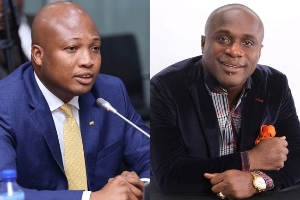NEWMONT GOLD Ghana Ltd (NGGL) in an interview with The Chronicle, has disclosed that the company has lost $30 million as a result of the energy crisis currently facing the nation.
Speaking to the paper, the General Manager, responsible for Environment and Social Responsibility, Mr. Dave Ingle also revealed that the lost had also affected the government’s income from the company’s operations.
According to Mr. Ingle, the government had a shortfall of $1million, being its 3% it supposed to earn from each ounce produced by the NGGL.
The General Manager quantifying the amount into gold production indicated that Newmont could not meet its target of 250,000ounces, but only produced 2000, since it first poured its first gold in July this year. The value of 200,000 ounces was $120 million with the government taking 3% out the total amount.
Mr. Ingle, attributing the shortfall to the current energy crisis in the country, revealed that the NGGL had taken a decision to acquire its own plant of 10 MW of power, as a standby plant for its gold extraction.
He told The Chronicle that next year, the company has estimated to produce 450,000 ounces and if proper measures were not put in place to combat the energy crisis internally, it may affect its operations, hence the need for the plant.
Meanwhile, Newmont in its bid to explore more gold in the Ahafo mining area, has began a feasibility study at the northern sector of the Ahafo lease area.
The second phase of the Newmont Project dubbed Ahafo Project stage 2, would look for possibilities of increasing plant capacity and possibly underground mining in the southern sector of the current project.
Briefing the media at a focus group meeting at Sunyani, Mr. Brain Anderson, Owners’ Representative of the Ahafo Project stage 2, said that there was a great deal of work necessary before a decision could be made on whether the project would go ahead or where to mine or what kind of infrastructure would be needed.
He continued that the operation of the stage 2 project would also be determined on where the company find gold, how much gold deposits available, the price of gold, the cost of time of mine development and other factors involving in mining sector.
Under the stage 2 project, the company would be looking into the Ghana regulations and Newmont standards on Environmental and Social Impact Assessment (ESIA).
The Environmental Protection Agency (EPA), according to Mr. Anderson, would independently assess its findings to determine whether additional conditions would be required for issuance of a revise environmental permit for the Ahafo project 2.
It was revealed to the media practitioners that the NGGL would coordinate a team of its employees, alongside with Ghanaian and international specialists in conducting the ESIA.
The phase 2 project, which would pay great emphasize on the people living in the community and people interested in the project advised that such people should contribute effectively to the ESIA.
The NGGL in line with this, has contracted a South African based consulting firm, Golder Associate Africa with an assistance of a Ghanaian firm, Refast to work with Newmont to complete the public consulting component of ESIA.
The Ahafo Project stage 2 would cover areas in the north of Ahafo as Afresepakrom, Adroba, Susuanso, Yamfo, Tekyere and down south to Wamahinso and Ntotoroso.
Also, the Subika pitch currently, where some surface mining is taking place, may see underground mining under the stage 2 project.
The feasibility study, according to Mr. Ingle in an interview, would cost the company about $12 to 15 million.
Business News of Monday, 18 December 2006
Source: Chronicle
















